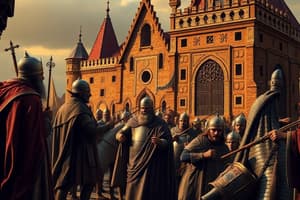Podcast
Questions and Answers
What was the role of monasteries during the Middle Ages?
What was the role of monasteries during the Middle Ages?
- They were responsible for collecting taxes from the peasants.
- They were the primary centers of education for the nobility.
- They were centers of military training for knights.
- They provided hospitality to refugees and travelers, and preserved ancient texts. (correct)
Which of the following best describes the structure of the medieval Roman Catholic Church?
Which of the following best describes the structure of the medieval Roman Catholic Church?
- It was a loosely organized group of independent monastic communities.
- It was a decentralized organization with no clear hierarchy.
- It was modeled after the structure of the ancient Roman government. (correct)
- It was led by a council of elected representatives from various regions.
What was the role of the pope in the medieval Roman Catholic Church?
What was the role of the pope in the medieval Roman Catholic Church?
- The pope was responsible for leading military campaigns against non-Christian territories.
- The pope was elected by the common people and served for a limited term.
- The pope was primarily responsible for overseeing the construction of churches and monasteries.
- The pope was the spiritual and political leader of the Church. (correct)
What was the role of cardinals in the medieval Roman Catholic Church hierarchy?
What was the role of cardinals in the medieval Roman Catholic Church hierarchy?
During the Middle Ages, which of the following statements about the Roman Catholic Church is true?
During the Middle Ages, which of the following statements about the Roman Catholic Church is true?
Study Notes
Carolingian Empire
- Charlemagne initiated the Saxon Wars in 772, which lasted until 804, and led to the conquest of pagan Saxony.
- Charlemagne was crowned as Roman Emperor by Pope Leo III on 25 December 800.
Partition and Decline
- In 817, Louis selected Lothar I as his heir and co-emperor, granting his other sons control over subordinate regions.
- Decentralization of the Carolingian Empire led to increased authority for local governments and lords, supporting the development of European feudalism and weakening the imperial throne.
The Split of Carolingian Empire
- The Carolingian Empire, led by Charlemagne, split into three parts: East Francia, Middle Francia, and West Francia, allocated to the sons of Louis the Pious.
- This split marked the beginning of the end for the empire.
Carolingian Dynasty
- Key figures in the Carolingian dynasty include:
- Louis IV (born 893, died 911)
- Saint Arnulf of Metz (born c. 580, died 640)
- Charles I (or II) (born 1365, died 1431)
- Arnulf of Carinthia (died 899)
- Grimoald (died 656, Paris)
- Pippin II (died 714, Jupille, near Liège)
- Pippin (born 777, died 810, Milan)
- Pippin III (born c. 714, died 768, Saint-Denis, Neustria)
- Berengar (died 924, son of Eberhard, Frankish margrave of Friuli)
Rise of the Carolingians
- By the end of 718, Charles Martel united the various regions of Francia under his sole mayoral authority.
- Charles Martel refused to install a new monarch after the death of the Merovingian king Theuderic IV in 737, effectively ruling over Francia himself until his death.
Charlemagne
- Charlemagne developed the Frankish kingdom into a prosperous Western and Central European empire by expanding his influence on all territorial fronts through conquest.
- Charlemagne reigned as King of the Franks (r. 768-814) and as Holy Roman Emperor (r. 800-814) following his coronation by Pope Leo III.
The Roman Catholic Church
- Initially, the Romans persecuted Christians for their beliefs, but in 313 C.E., the Roman emperor Constantine issued a decree allowing Christians to practice their religion freely.
- In 395 C.E., Christianity became the official religion of the Roman Empire.
- During the Middle Ages, the Church played a vital role in society, providing leadership, organizing the distribution of food, and preserving old texts.
- The Church hierarchy was organized with a system of ranked clergy, including:
- Pope – the spiritual and political leader of the church
- Cardinals – appointed by the pope and serving as advisors to the Pope; administrators of the Church
Studying That Suits You
Use AI to generate personalized quizzes and flashcards to suit your learning preferences.
Description
Test your knowledge on Charlemagne, the first Holy Roman Emperor, and the Carolingian Empire. This quiz covers topics such as the Saxon Wars, alliance with Pope Leo III, and the crowning as Roman Emperor.




